MaryAnn Bernal's Blog, page 399
July 11, 2013
The Phil Naessens Show 7-11-2013 Dwight Howard and Andrew Bynum Have New Homes
http://phillipnaessens.wordpress.com/2013/07/11/the-phil-naessens-show-7-11-2013-dwight-howard-and-andrew-bynum-have-new-homes/
 Dwight Howard and Andrew Bynum have found new homes but they aren’t the only NBA stories. Joining host Phil Naessens for OKC Thunder news is J.A. Sherman, Michael Levin joins Phil to talk Philadelphia 76ers hoops and Kevin Lipe gives us all the latest news from the Memphis Grizzlies on today’s Phil Naessens Show.
Dwight Howard and Andrew Bynum have found new homes but they aren’t the only NBA stories. Joining host Phil Naessens for OKC Thunder news is J.A. Sherman, Michael Levin joins Phil to talk Philadelphia 76ers hoops and Kevin Lipe gives us all the latest news from the Memphis Grizzlies on today’s Phil Naessens Show.
 Dwight Howard and Andrew Bynum have found new homes but they aren’t the only NBA stories. Joining host Phil Naessens for OKC Thunder news is J.A. Sherman, Michael Levin joins Phil to talk Philadelphia 76ers hoops and Kevin Lipe gives us all the latest news from the Memphis Grizzlies on today’s Phil Naessens Show.
Dwight Howard and Andrew Bynum have found new homes but they aren’t the only NBA stories. Joining host Phil Naessens for OKC Thunder news is J.A. Sherman, Michael Levin joins Phil to talk Philadelphia 76ers hoops and Kevin Lipe gives us all the latest news from the Memphis Grizzlies on today’s Phil Naessens Show.
Published on July 11, 2013 05:57
Gladiator's Pen: OneWord/60 Seconds: Derived
Gladiator's Pen: OneWord/60 Seconds: Derived: OneWord.com is a website for getting the muse warmed up. Each day you get one word and sixty seconds in which to write what it inspires . ...
Published on July 11, 2013 05:34
History Trivia - Treaty of Saint-Clair-sur-Epte creates duchy of Normandy
July 11
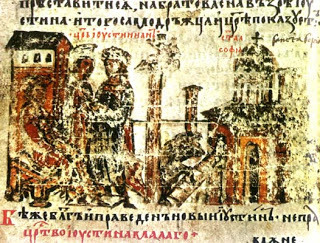 472 after being besieged in Rome by his own generals, Western Roman Emperor Anthemius was captured in the Old St. Peter's Basilica and put to death.
472 after being besieged in Rome by his own generals, Western Roman Emperor Anthemius was captured in the Old St. Peter's Basilica and put to death.
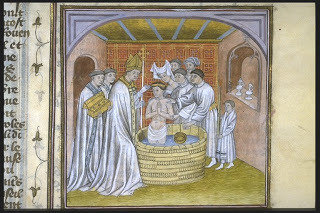 Baptism of Rollo
Baptism of Rollo

911 The Treaty of Saint-Clair-sur-Epte between Charles the Simple of France and Rollo leader of the Vikings was signed. The treaty protected Charles kingdom from further invasion and created the duchy of Normandy; the Vikings became known as Normans. Also Rollo agreed to be baptized and to marry the illegitimate daughter of Charles, thus becoming the king's vassal.
1346 Charles IV of Luxembourg was elected Holy Roman Emperor in Germany.
1533 Pope Clement VII excommunicated England's King Henry VIII.
 472 after being besieged in Rome by his own generals, Western Roman Emperor Anthemius was captured in the Old St. Peter's Basilica and put to death.
472 after being besieged in Rome by his own generals, Western Roman Emperor Anthemius was captured in the Old St. Peter's Basilica and put to death.  Baptism of Rollo
Baptism of Rollo

911 The Treaty of Saint-Clair-sur-Epte between Charles the Simple of France and Rollo leader of the Vikings was signed. The treaty protected Charles kingdom from further invasion and created the duchy of Normandy; the Vikings became known as Normans. Also Rollo agreed to be baptized and to marry the illegitimate daughter of Charles, thus becoming the king's vassal.
1346 Charles IV of Luxembourg was elected Holy Roman Emperor in Germany.
1533 Pope Clement VII excommunicated England's King Henry VIII.
Published on July 11, 2013 04:42
July 10, 2013
The Wizard of Notts recommends: Ashes 2013: the myth of the urn
http://www.telegraph.co.uk/sport/cricket/international/theashes/10169521/Ashes-2013-the-myth-of-the-urn.html
The Telegraph - published July 10, 2013
Ashes 2013: the myth of the urnThe story behind how a Test match series between England and Australia became known as 'The Ashes' is a long and convoluted tale that can be traced back to Cobham Hall. The school's headmaster explains the history of the famous urn. >
5:27PM BST 09 Jul 2013 6 Comments Unlikely as it may seem, Cobham Hall - now a private girls' school - played a key role in the origin and history of cricket's
Ashes
series between England and Australia. The story dates back to August 1882, when England lost to Australia for the first time on home soil at the Oval in London. Subsequently, the 'Sporting Times' newspaper published a satirical obituary bemoaning 'the death of English cricket', such was the horror at England suffering such a humiliating defeat. 'Deeply lamented by a large circle of sorrowing friends and acquaintances', the obituary read, 'the body will be cremated and the ashes taken to Australia.' A few weeks later, an English team, captained by Ivo Bligh - later the 8th Earl of Darnley - set off to tour Australia, with Bligh vowing to return with 'the ashes' and restore English honour. Related ArticlesCook: England team 'nervous and excited'
6 Comments Unlikely as it may seem, Cobham Hall - now a private girls' school - played a key role in the origin and history of cricket's
Ashes
series between England and Australia. The story dates back to August 1882, when England lost to Australia for the first time on home soil at the Oval in London. Subsequently, the 'Sporting Times' newspaper published a satirical obituary bemoaning 'the death of English cricket', such was the horror at England suffering such a humiliating defeat. 'Deeply lamented by a large circle of sorrowing friends and acquaintances', the obituary read, 'the body will be cremated and the ashes taken to Australia.' A few weeks later, an English team, captained by Ivo Bligh - later the 8th Earl of Darnley - set off to tour Australia, with Bligh vowing to return with 'the ashes' and restore English honour. Related ArticlesCook: England team 'nervous and excited'
09 Jul 2013 Lions roar on England's Ashes team
10 Jul 2013 Clarke: I'm amazed England axed Compton
09 Jul 2013 Shane Warne - how to beat England
09 Jul 2013 Cook: we can continue summer of success
09 Jul 2013 PM leads Ashes good luck message
09 Jul 2013 It is here that Cobham Hall becomes involved, as this was the home of the Darnley family.
Bligh completed his tour, won the series 2-1 and following a social game which was not part of the 'official' series, he was presented with a small terracotta urn by a group of women from Melbourne as a symbol of the ashes that he had travelled to Australia to regain.
He brought the urn back to England and kept it at home at Cobham Hall.
Paul Mitchell, the modern-day Headmaster of Cobham Hall School, takes up the story:
"He (Bligh) actually brought it back here rather as a memento as much as anything else, and not only did the urn come back, he also brought back one of the ladies who had presented this urn to him. And later on she became his wife."
What the urn actually contained has also been a source of intense speculation down the years, with doubt cast over the claims that the ashes were those of a bail from the match where Australia defeated England.
"I've heard other stories which say that it wasn't a bail at all, it was part of an item of clothing from one of the ladies, they couldn't find a bail, couldn't get hold of one, so they burned an item of clothing," Mr Mitchell said.
"But when it was here, being kept here, the story is that the butler was cleaning the mantlepiece one day, knocked the urn over, spilling out the ashes, so what on earth could he do to cover up his misdemeanour he pushed some ash fro the fire back into the urn and put the top back in and left it, hoping no-one would notice," he added.
The urn stayed on the mantelpiece at Cobham Hall until Bligh's death, 43 years later.
At his request, Florence bequeathed the urn to the Marylebone Cricket Club (MCC) and today, the tiny artefact resides in the MCC Museum at Lord's.
Over the years the urn came to represent much more than just an amusing anecdote from the nineteenth century and since there was no trophy for the winners of series between the two countries, it evolved into the role.
"It symbolises the rivalry between the two nations," says MCC curator Adam Chadwick, "It's been broken, it is very fragile, it's ceramic. It has only been put onto its wooden base - the wooden base that you see now - to strengthen it, so it would never work out as a trophy for the series."
The MCC closely guards the original urn and has resisted repeated requests for it to be taken back to Australia, even on a temporary basis.
There is an 'official replica', but that has now become so precious that the MCC is reluctant to see it go too far.
"I'll not forget 2005 when we leant the official replica to the England team," Mr Chadwick recalled.
"I think it was Andrew Flintoff who held it up to the camera and then blithely tossed it over his shoulder to Steve Harmison, who managed to catch it, but even so it came back to us in a pretty well-worn state."
The latest clash between England and Australia begins at Trent Bridge on Wednesday, the first of an unprecedented 10 Test matches in England and Australia over the course of the next seven months.
Source: APTN
The Telegraph - published July 10, 2013
Ashes 2013: the myth of the urnThe story behind how a Test match series between England and Australia became known as 'The Ashes' is a long and convoluted tale that can be traced back to Cobham Hall. The school's headmaster explains the history of the famous urn. >
5:27PM BST 09 Jul 2013
 6 Comments Unlikely as it may seem, Cobham Hall - now a private girls' school - played a key role in the origin and history of cricket's
Ashes
series between England and Australia. The story dates back to August 1882, when England lost to Australia for the first time on home soil at the Oval in London. Subsequently, the 'Sporting Times' newspaper published a satirical obituary bemoaning 'the death of English cricket', such was the horror at England suffering such a humiliating defeat. 'Deeply lamented by a large circle of sorrowing friends and acquaintances', the obituary read, 'the body will be cremated and the ashes taken to Australia.' A few weeks later, an English team, captained by Ivo Bligh - later the 8th Earl of Darnley - set off to tour Australia, with Bligh vowing to return with 'the ashes' and restore English honour. Related ArticlesCook: England team 'nervous and excited'
6 Comments Unlikely as it may seem, Cobham Hall - now a private girls' school - played a key role in the origin and history of cricket's
Ashes
series between England and Australia. The story dates back to August 1882, when England lost to Australia for the first time on home soil at the Oval in London. Subsequently, the 'Sporting Times' newspaper published a satirical obituary bemoaning 'the death of English cricket', such was the horror at England suffering such a humiliating defeat. 'Deeply lamented by a large circle of sorrowing friends and acquaintances', the obituary read, 'the body will be cremated and the ashes taken to Australia.' A few weeks later, an English team, captained by Ivo Bligh - later the 8th Earl of Darnley - set off to tour Australia, with Bligh vowing to return with 'the ashes' and restore English honour. Related ArticlesCook: England team 'nervous and excited' 09 Jul 2013 Lions roar on England's Ashes team
10 Jul 2013 Clarke: I'm amazed England axed Compton
09 Jul 2013 Shane Warne - how to beat England
09 Jul 2013 Cook: we can continue summer of success
09 Jul 2013 PM leads Ashes good luck message
09 Jul 2013 It is here that Cobham Hall becomes involved, as this was the home of the Darnley family.
Bligh completed his tour, won the series 2-1 and following a social game which was not part of the 'official' series, he was presented with a small terracotta urn by a group of women from Melbourne as a symbol of the ashes that he had travelled to Australia to regain.
He brought the urn back to England and kept it at home at Cobham Hall.
Paul Mitchell, the modern-day Headmaster of Cobham Hall School, takes up the story:
"He (Bligh) actually brought it back here rather as a memento as much as anything else, and not only did the urn come back, he also brought back one of the ladies who had presented this urn to him. And later on she became his wife."
What the urn actually contained has also been a source of intense speculation down the years, with doubt cast over the claims that the ashes were those of a bail from the match where Australia defeated England.
"I've heard other stories which say that it wasn't a bail at all, it was part of an item of clothing from one of the ladies, they couldn't find a bail, couldn't get hold of one, so they burned an item of clothing," Mr Mitchell said.
"But when it was here, being kept here, the story is that the butler was cleaning the mantlepiece one day, knocked the urn over, spilling out the ashes, so what on earth could he do to cover up his misdemeanour he pushed some ash fro the fire back into the urn and put the top back in and left it, hoping no-one would notice," he added.
The urn stayed on the mantelpiece at Cobham Hall until Bligh's death, 43 years later.
At his request, Florence bequeathed the urn to the Marylebone Cricket Club (MCC) and today, the tiny artefact resides in the MCC Museum at Lord's.
Over the years the urn came to represent much more than just an amusing anecdote from the nineteenth century and since there was no trophy for the winners of series between the two countries, it evolved into the role.
"It symbolises the rivalry between the two nations," says MCC curator Adam Chadwick, "It's been broken, it is very fragile, it's ceramic. It has only been put onto its wooden base - the wooden base that you see now - to strengthen it, so it would never work out as a trophy for the series."
The MCC closely guards the original urn and has resisted repeated requests for it to be taken back to Australia, even on a temporary basis.
There is an 'official replica', but that has now become so precious that the MCC is reluctant to see it go too far.
"I'll not forget 2005 when we leant the official replica to the England team," Mr Chadwick recalled.
"I think it was Andrew Flintoff who held it up to the camera and then blithely tossed it over his shoulder to Steve Harmison, who managed to catch it, but even so it came back to us in a pretty well-worn state."
The latest clash between England and Australia begins at Trent Bridge on Wednesday, the first of an unprecedented 10 Test matches in England and Australia over the course of the next seven months.
Source: APTN
Published on July 10, 2013 06:28
The Phil Naessens Show 7-10-2013 Should New York Mets Fans Believe in the 2013 New York Mets?
http://phillipnaessens.wordpress.com/2013/07/10/the-phil-naessens-show-7-10-2013-should-new-york-mets-fans-believe-in-the-2013-new-york-mets/

Should New York Mets fans believe in the 2013 NY Mets? Blogging Mets Mark Berman and host Phil Naessens discuss this plus all the latest news as well as a lively discussion on who the guys would trade if they were Sandy Alderson and much more on today’s Phil Naessens Show

Should New York Mets fans believe in the 2013 NY Mets? Blogging Mets Mark Berman and host Phil Naessens discuss this plus all the latest news as well as a lively discussion on who the guys would trade if they were Sandy Alderson and much more on today’s Phil Naessens Show
Published on July 10, 2013 05:38
History Trivia - Lady Godiva rides naked through the streets of Coventry
July 10
48 BC Battle of Dyrrhachium: Julius Caesar barely avoided a catastrophic defeat to Pompey in Macedonia.
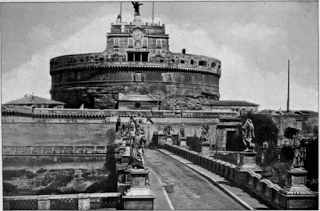
138 Emperor Hadrian died of heart failure at Baiae at age 62; he was buried in Rome in the Tomb of Hadrian beside his late wife, Vibia Sabina.
988 The city of Dublin was founded on the banks of the river Liffey.

1040 Lady Godiva rode naked on horseback to force her husband, the Earl of Mercia, to lower taxes.
1086 Knut IV, the Saint, King of Denmark was murdered. 1
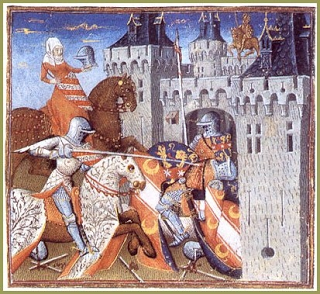
099 El Cid, of Castile died.
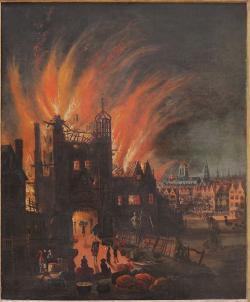
1212 The most severe of several early fires of London burned most of the city to the ground.
1452 King James III of Scotland was born. 1
460 - Wars of Roses: Richard of York defeated King Henry VI at Northampton.
1520 King Charles V & King Henry VIII signed treaty of Calais.
48 BC Battle of Dyrrhachium: Julius Caesar barely avoided a catastrophic defeat to Pompey in Macedonia.

138 Emperor Hadrian died of heart failure at Baiae at age 62; he was buried in Rome in the Tomb of Hadrian beside his late wife, Vibia Sabina.
988 The city of Dublin was founded on the banks of the river Liffey.

1040 Lady Godiva rode naked on horseback to force her husband, the Earl of Mercia, to lower taxes.
1086 Knut IV, the Saint, King of Denmark was murdered. 1

099 El Cid, of Castile died.

1212 The most severe of several early fires of London burned most of the city to the ground.
1452 King James III of Scotland was born. 1
460 - Wars of Roses: Richard of York defeated King Henry VI at Northampton.
1520 King Charles V & King Henry VIII signed treaty of Calais.
Published on July 10, 2013 05:35
The Wizard's Cauldron: Norse Mythology and Romance: An Interview with ST ...
The Wizard's Cauldron: Norse Mythology and Romance: An Interview with ST ...: ST Bende Before finding domestic bliss in suburbia, ST Bende lived in Manhattan Beach (became overly fond of Peet’s Coffee) and Europ...
Published on July 10, 2013 04:31
July 9, 2013
The Phil Naessens Show Fantasy Baseball Tuesday!
http://phillipnaessens.wordpress.com/2013/07/09/the-phil-naessens-show-fantasy-baseball-tuesday/
 Its the Fantasy Baseball Tuesday edition of the Phil Naessens Show and joining host Phil Naessens is Fantasy Baseball Crackerjacks writer Eric Pleiss to discuss injuries, possible replacements as well as who’s been hot and who hasn’t and as an added bonus we have music from the Greek metal band Veil Enigma!
Its the Fantasy Baseball Tuesday edition of the Phil Naessens Show and joining host Phil Naessens is Fantasy Baseball Crackerjacks writer Eric Pleiss to discuss injuries, possible replacements as well as who’s been hot and who hasn’t and as an added bonus we have music from the Greek metal band Veil Enigma!
 Its the Fantasy Baseball Tuesday edition of the Phil Naessens Show and joining host Phil Naessens is Fantasy Baseball Crackerjacks writer Eric Pleiss to discuss injuries, possible replacements as well as who’s been hot and who hasn’t and as an added bonus we have music from the Greek metal band Veil Enigma!
Its the Fantasy Baseball Tuesday edition of the Phil Naessens Show and joining host Phil Naessens is Fantasy Baseball Crackerjacks writer Eric Pleiss to discuss injuries, possible replacements as well as who’s been hot and who hasn’t and as an added bonus we have music from the Greek metal band Veil Enigma!
Published on July 09, 2013 06:42
History Trivia - Jane Grey proclaimed queen of England
July 9,
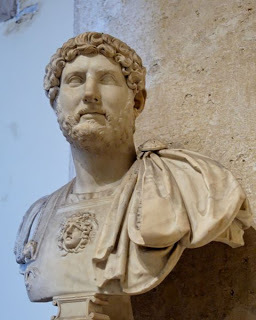 118 Hadrian, Rome's new emperor, made his entry into the city.
118 Hadrian, Rome's new emperor, made his entry into the city.
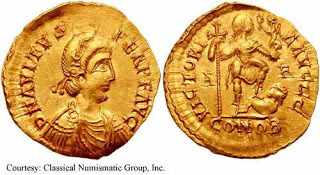
455 Avitus, the Roman military commander in Gaul, became Emperor of the West.

1357 Emperor Charles IV assisted in laying the foundation stone of Charles Bridge in Prague.

1540 King Henry VIII of England annulled his marriage to his fourth wife, Anne of Cleves.

1553 Lady Jane Grey was proclaimed queen of England in succession to Edward VI, who died three days earlier. Her reign lasted nine days since Mary Tudor (daughter of Henry VIII and Catherine of Aragon) claimed the right of succession.
 118 Hadrian, Rome's new emperor, made his entry into the city.
118 Hadrian, Rome's new emperor, made his entry into the city. 
455 Avitus, the Roman military commander in Gaul, became Emperor of the West.

1357 Emperor Charles IV assisted in laying the foundation stone of Charles Bridge in Prague.

1540 King Henry VIII of England annulled his marriage to his fourth wife, Anne of Cleves.

1553 Lady Jane Grey was proclaimed queen of England in succession to Edward VI, who died three days earlier. Her reign lasted nine days since Mary Tudor (daughter of Henry VIII and Catherine of Aragon) claimed the right of succession.
Published on July 09, 2013 05:48
July 8, 2013
Gladiator's Pen: Moving Forward One Word at a Time
Gladiator's Pen: Moving Forward One Word at a Time: "I used Grammarly to grammar check this post, because .a money in a barrel has better grammar than I some days." There will...
Published on July 08, 2013 07:59



